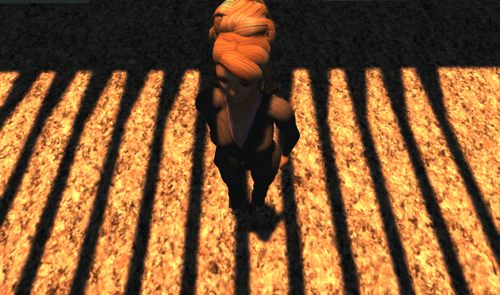We’re really pleased to feature a guest post from Ariella Furman (SL: Ariella Languish), who has been producing machinima for a number of years (you can view some here).
 When I used to take the train home from school everyday, I would admire how the lighting outside would seep over the windows, until they were a golden hue and it was too bright to see through them. It was like all the people, ending their active work days, would be lost in a tunnel of celestial yellow skies. You couldn’t help but smile, no matter how bad your day was.
When I used to take the train home from school everyday, I would admire how the lighting outside would seep over the windows, until they were a golden hue and it was too bright to see through them. It was like all the people, ending their active work days, would be lost in a tunnel of celestial yellow skies. You couldn’t help but smile, no matter how bad your day was.
Many real life filmmakers will argue, “Light is shadow.” Light is what makes shapes and colors have their quality. It has substance, texture, mood, etc. It has more dimensions and beauty than any other thing I know.
Light is not all grand, however. When on a film set, what always takes the longest and the most time tweaking? The lights! There are so many options. There are so many ways to tell the story. Simply by putting the main character in a sea of shadow, you can change the whole dynamic of what you’re conveying to the audience.
Second Life once had a world with limited shadows. We could change the color and tones of the light, but it was meaningless without seeing the light react with objects. Now, with two new Shadow Viewers out from KirstenLee and BoyLane, we have the world of lighting at our disposal.

We machinimatographers are luckier than the poor director of photographers in the real world, however. Our lights change with a few button clicks. However, I don’t think it will make us lazy. It just means that setting up our shots will probably be more time consuming. You now not only have to set the actors, but also wonder about how they will react with the world around them.
We’ll have to answer questions. Are they troubled? Do they see the glass half full, half empty? Even the shadow of their figure trailing behind them – if it is small and opaque, it means they have a direction and are confident. If it is long and dull, it probably means they have a whole journey ahead of them and that they are troubled about their direction.
Does the building they enter have pillars? If so, do those pillars seem to have long, never-ending shadows that paint the floor in lines of blacks, making it appear like they are entering a jail cell rather than a building?
So, in conclusion, filmmaking is 90% talking about what you’re going to shoot and setting it up but only 10% actually shooting it. Let’s face it, back in the day, machinima was a cinch! Now that we have dozens of creative options to tell the same message, most of our work flow will probably be decision making. Less machinimators will want to just “wing it” if they want a professional product.
Let’s face it, machinima just became way more similar to real life narrative filmmaking. This means the world and more to many of us.
#^$(*^%)(*&#@%*&*(^&%#$#!!!!!!!!!!!!
Already time to upgrade the video card rofl!
Seriously. I have seen some snaps from SL that put my nvidea 8000 series card to shame.
It really does make a difference.
#^$(*^%)(*&#@%*&*(^&%#$#!!!!!!!!!!!!
Already time to upgrade the video card rofl!
Seriously. I have seen some snaps from SL that put my nvidea 8000 series card to shame.
It really does make a difference.